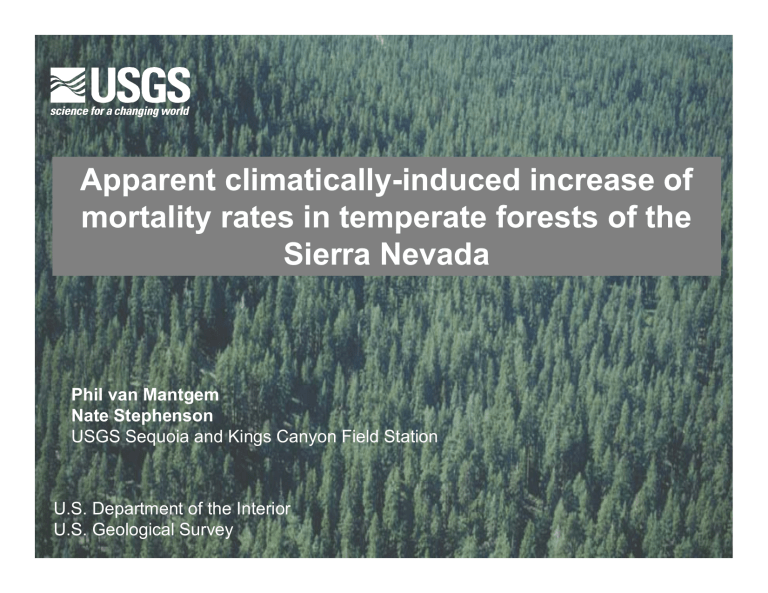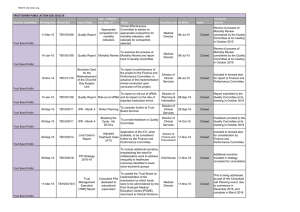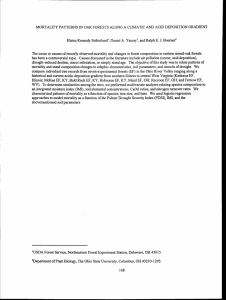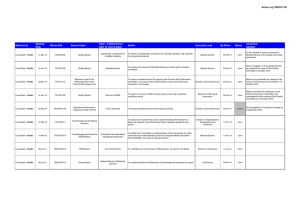Apparent climatically-induced increase of mortality rates in temperate forests of the
advertisement

Apparent climatically-induced increase of mortality rates in temperate forests of the Sierra Nevada Phil van Mantgem Nate Stephenson USGS Sequoia and Kings Canyon Field Station U.S. Department of the Interior U.S. Geological Survey The Western Mountain Initiative The Upshot Background mortality rates are increasing in old growth forests of the Sierra Nevada. Increasing mortality rates appear to be related to increasing water stress. A growing body of evidence suggests that environment (particularly climate) affects forest demographic rates Large-scale die-off Credit: USFS Background mortality Credit: N. Stephenson A growing body of evidence suggests that environment (particularly climate) affects forest demographic rates Large-scale die-off Background mortality (1) subtle, slow, neglected (2) ... but important! Credit: USFS Tropical forests are changing RAINFOR plot network • Increasing recruitment and mortality rates (Phillips et al. 2004) • Increasing stand biomass (Körner et al. 2004) • Changes in species composition (increasing liana densities) (Phillips et al. 2002, Laurence et al. 2004) Credit: O. Phillips Credit: Y. Malhi Could similar changes be occurring in temperate forests? To find out, we used 21 long-term old-growth forest plots: -- Established 1982-1994 -- 0.9 to 2.5 ha (26 ha total) -- 1900 m elevational gradient -- Excludes “disturbed” plots -- The fates of > 20,000 trees (≥1.4 m tall) tracked annually -- Causes of death recorded Yosemite transect Sequoia transect Credit: USGS No change in ingrowth rates in the Sierra Nevada Annual ingrowth rate (%) Thick black line, mean 3 2 1 0 1984 1988 1992 1996 Year 2000 2004 No change in ingrowth rates in the Sierra Nevada 3 y = 2 .7 6 - 0 .0 0 0 6 6 x -1 Forest turnover (% yr ) Forest vs. seedling demographics r 2 = 0 .4 9 , P < 0 .0 0 1 2 1 0 1500 2000 2500 3000 -1 Seedling turnover (% yr ) E le v a tio n ( m ) 20 3500 Stephenson and van Mantgem (2005) y = 0 .1 5 9 - 0 .0 0 0 0 4 x R 2 = 0 .2 1 , P = 0 .0 4 6 15 10 5 0 1500 2000 2500 3000 E le v a tio n (m ) 3500 van Mantgem and Stephenson (2006) Mortality rates are increasing in the Sierra Nevada Annual mortality rate (%) Thick black line, mean 3 2 1 0 1984 1988 1992 1996 Year 2000 2004 Trends in stand biomass Increased mortality from self-thinning? • Biomass from allometric equations (Means et al. 1994, BIOPAK) • No detectable biomass trend (P = 0.99) -1 Live stem biomass (Mg ha ) • Increased mortality primarily in small trees (<20 cm DBH) 1500 1000 500 0 1984 1988 1992 1996 2000 2004 Year Mortality rates are increasing in the Sierra Nevada Annual mortality rate (%) Abies increase = 3% yr-1, P = 0.0001 Pinus increase = 9% yr-1, P < 0.0001 Abies Pinus 5 4 3 2 1 0 1984 1988 1992 Year 1996 2000 2004 Mortality rates are increasing in the Sierra Nevada Pinus species Credit: NPS Forest structure and composition change profoundly over elevation, controlled by the climatic water balance. Credit: Tony Caprio Mortality rates are increasing in the Sierra Nevada Annual mortality rate (%) Low (1500 - 2000 m) increase = 2% yr-1, P = 0.52, n = 4 plots Mid (2000 - 2400 m) increase = 3% yr-1, P = 0.001, n = 8 plots High (2400 - 2600 m) increase = 9% yr-1, P < 0.0001, n = 5 plots Veryhigh (2600 – 3500 m) increase = -2% yr-1, P = 0.56, n = 4 plots low mid high veryhigh 3 2 1 0 1984 1988 1992 Year 1996 2000 2004 Mortality rates are increasing in the Sierra Nevada but not uniformly! Subalpine plots a) No trend b) Low sample size, n = 4 3 y = 2 .7 6 - 0 .0 0 0 6 6 x -1 Forest turnover (% yr ) c) Trend hard to detect 2 r = 0 .4 9 , P < 0 .0 0 1 2 1 0 1500 2000 2500 3000 3500 E le v a tio n ( m ) Stephenson and van Mantgem (2005) The Upshot Background mortality rates are increasing in old growth forests of the Sierra Nevada. Increasing mortality rates appear to be related to increasing water stress. Mortality rates are increasing in the Sierra Nevada Annual mortality rate (%) Thick black line, mean Drought 3 2 1 0 1984 1988 1992 1996 Year 2000 2004 Changes for the Sierra Nevada Temperature increases March – April Temps 1950-1997 Cayan et al (2001) Changes for the Sierra Nevada Maximum snow water content Summers are getting longer and drier. Snowpack has been decreasing over most of the West in recent decades … Mote et al., 2005 … and spring streamflow has been arriving earlier. Spring-pulse dates Stewart et al., 2004 Photo credit: A. Caprio Modeled climatic trends 12 8 Min. temperature = increasing (P < 0.0001) 4 0 -4 16 Max. temperature = increasing (P < 0.0001) 12 8 2000 1500 Precipitation = no trend (P = 0.49) 1000 Water deficit (mm) Precipitation (mm) Maximum temperature (oC) Minimum o temperature ( C) Thick black line, mean 500 400 1984 1988 1992 1996 2000 2004 Annual water deficit = increasing (P < 0.0001) Year 300 200 100 0 1984 1988 1992 Year 1996 2000 2004 Water balance: integrating temperature and precipitation mm Water 150 100 S D 50 AET 0 1 J F2 3 M 4 A 5 M J6 7J 8 A 9 S 10 O 11 N 12 D Month Compared with traditional measures of climate, AET and D better represent aspects of climate of direct physiological importance to plants (Stephenson 1990) AET: D: Climatic potential for primary production Drought stress, (PET – AET = D) 2.0 Average annual mortality rate Water deficit (3 yr. running average) 280 260 240 1.5 220 1.0 200 180 0.5 160 0.0 1985 1990 1995 2000 Year βyear = 0.02, s.e. = 0.01, P = 0.04 βD = 0.002, s.e. = 0.001, P = 0.03 2005 Water Deficit (mm) Annual mortalityrate (%) Water deficit partially explains mortality rate trend Developing a mechanistic understanding Stress mortality (standing dead: insects, fungi, or no symptoms) Mechanical mortality (breaking, uprooting, or crushing) Stress = 3356 deaths Mechanical = 542 deaths Stress 86% Mechanical 14% Related to water deficit Related to storm intensity βyear = 0.01, s.e. = 0.01, P = 0.21 βD = 0.004, s.e. = 0.001, P = 0.002 Average annual stress mortality rate Water deficit (3 yr. running average) 2.0 280 260 240 1.5 220 1.0 200 180 0.5 Water deficit (mm) Stress mortality Annual mortality rate (%) Developing a mechanistic understanding 160 0.0 1984 1988 1992 1996 2000 2004 βyear = 0.03, s.e. = 0.02, P = 0.13 βmax.3.precip = 0.001 s.e. = 0.0002, P = 0.0004 Average annual mechanical mortality rate Sum max 3 mo. precip. 1200 Precipitation (mm) Mechanical mortality Annual mortality rate (%) Year 1000 1.0 800 0.5 600 400 0.0 1984 1988 1992 Year 1996 2000 2004 The decline spiral model of tree death recovery healthy tree drought suppression death pitch defense dominance recovery bark beetles competition Franklin et al. 1987 Mountain pine beetle increasing range in British Columbia Carroll et al. 2003 The Upshot Background mortality rates are increasing in old growth forests of the Sierra Nevada. Increasing mortality rates appear to be related to increasing water stress. Hemingway on long-term research There are some things which cannot be learned quickly, and time...must be paid heavily for their acquiring. -- Ernest Hemingway Hemingway was a jerk. -- Harold Robbins Die-back event of piñon pine in the Southwest October 2002 May 2004 Photo credit: C. Allen Die-back event of piñon pine in the Southwest Annual temperature (oC) Annual precipitation (mm) Die-back occurred in the context of increasing temperatures coupled with a reduction in precipitation -leading to stronger drought response than in the past! Breshears et al. 2005 Changes are occurring in conjunction with other stressors Credit: Eric Knapp Credit: USFS Air pollution Forest fragmentation Credit: USFS Altered disturbance regimes Credit: Eric Knapp Invasive species






